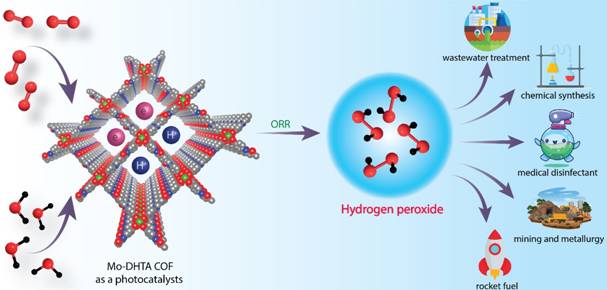Ministry of Science & Technology
Photocatalytic leap toward green synthesis of hydrogen peroxide disinfectant
प्रविष्टि तिथि:
17 JUL 2025 5:13PM by PIB Delhi
Sunlight and water could now be turned into a powerful disinfectant - Hydrogen peroxide (H₂O₂) - using a photocatalyst. The new method of synthesis of this chemical, with uses ranging from cleaning wounds, purifying water, powering fuel cells and driving industrial chemistry, could open up new avenues for green chemistry.
Hydrogen peroxide (H2O2) is a vital oxidizing agent with broad applications in chemical synthesis, sterilization, wastewater treatment, and fuel cells. Known for its eco-friendly nature of degrading or breaking down into only water and oxygen - H2O2 is a key component in sustainable chemical processes. However, its conventional production methods are energy-intensive, environmentally hazardous, and costly.
Traditional photocatalysts like metal oxides, graphitic carbon nitride (g-C3N4), polymers and metal organic frameworks (MOFs) face limitations due to wide band gaps and limited stability. In contrast, Covalent Organic Frameworks (COFs) provide advantages like high surface area, tunable porosity, narrow band gaps, and photostability. Still, they often lack active sites and efficient electron mobility. Embedding metal centres into COFs (forming M-COFs) addresses these issues, enhancing catalytic activity, charge separation, and overall photocatalytic performance.
In a significant scientific breakthrough, researchers from S. N. Bose Centre for Basic Sciences (SNBCBS), an autonomous institute of the Department of Science and Technology (DST), have developed a novel approach for using a cutting-edge material called Mo-DHTA COF, short for dimolybdenum paddlewheel-embedded covalent organic framework for synthesizing H2O2 directly from water and sunlight. This innovation offers a cleaner, more efficient, and recyclable route for hydrogen peroxide production, potentially transforming industries such as pharmaceuticals, green chemistry, and materials science.

Fig 1. Photocatalytic hydrogen peroxide generation using M-COFs for various applications.
The Mo-DHTA COF integrates dimolybdenum paddlewheel units with α-hydroquinone linkers, which are aromatic organic derivatives of benzene with hydroxyl groups at a para position, forming a robust framework capable of binding oxygen and facilitating its reduction under visible light. Upon light irradiation, the material, which acts like a highly organized molecular scaffold, studded with metal atoms that act like mini solar-powered factories, generates excitons, which drive the photocatalytic reactions. Electrons reduce oxygen to superoxide radicals, which then react with protons and additional electrons to produce H2O2.
Remarkably, this material demonstrates outstanding photocatalytic efficiency in different media, generating substantial amounts of hydrogen peroxide in ethanol and benzyl alcohol and even functioning effectively in pure water. Furthermore, the Mo-DHTA COF exhibits excellent structural stability and recyclability, making it a durable catalyst for long-term use. The study by the team consisting of Bidhan Kumbhakar, Avanti Chakraborty, Uttam Pal, Gaurav Jhaa, Sukanta Mondal, Abhik Banerjee, Tanusri Saha-Dasgupta and Pradip Pachfule was published in the journal –‘Small’.
This innovation opens up new avenues in the Pharmaceutical and healthcare sectors, by enabling more cost-effective and sustainable H₂O₂ production, Environmental remediation, through green methods of sterilization and pollutant treatment and Materials and energy science, with potential applications in water splitting, CO₂ reduction, and the generation of value-added chemicals. Future research will likely focus on optimizing the structure and composition of M-COFs for even greater performance and scaling the technology for industrial use. Exploring other metal-embedded frameworks may also yield further improvements in efficiency and sustainability.
The development of Mo-DHTA COF represents a major leap forward in photocatalytic technology. By harnessing sunlight and water under eco-friendly conditions, it provides a promising alternative to traditional methods, marking a pivotal step toward cleaner, low-cost, greener chemical synthesis with wide-reaching industrial impact. Scaling this technology could change how we make not just hydrogen peroxide, but a whole array of green chemicals.
*****
NKR/PSM
(रिलीज़ आईडी: 2145542)
आगंतुक पटल : 151